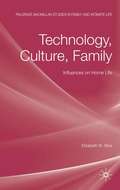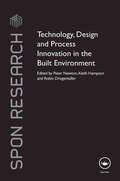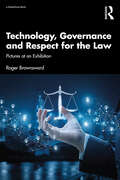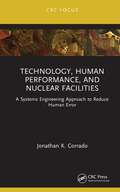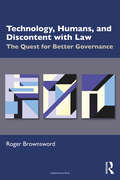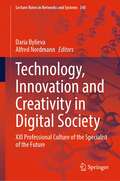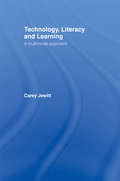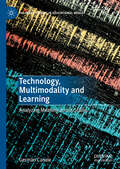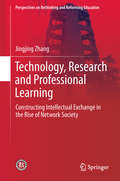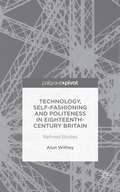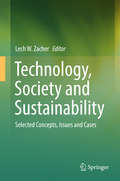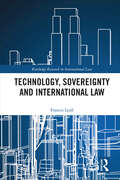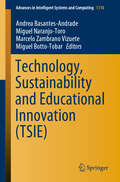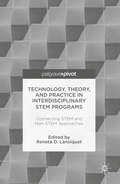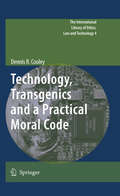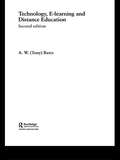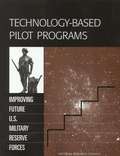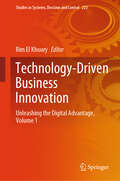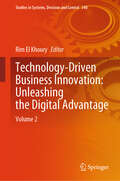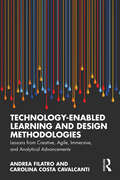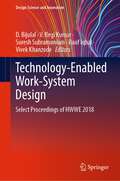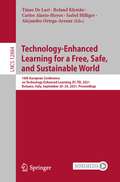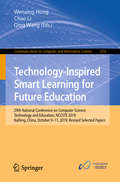- Table View
- List View
Technology, Culture, Family
by Elizabeth B. SilvaThis book examines connections between personal, relational and material matters in everyday life in the context of broader and long standing social problems. It explores the connections between mundane practices in the reproduction of our bodies and our relations with those we live with, and the technological practices that inform daily life.
Technology, Design and Process Innovation in the Built Environment (Spon Research)
by Keith Hampson Peter Newton Robin DrogemullerBuildings and infrastructure represent principal assets of any national economy as well as prime sources of environmental degradation. Making them more sustainable represents a key challenge for the construction, planning and design industries and governments at all levels; and the rapid urbanisation of the 21st century has turned this into a global challenge. This book embodies the results of a major research programme by members of the Australia Co-operative Research Centre for Construction Innovation and its global partners, presented for an international audience of construction researchers, senior professionals and advanced students. It covers four themes, applied to regeneration as well as to new build, and within the overall theme of Innovation: Sustainable Materials and Manufactures, focusing on building material products, their manufacture and assembly – and the reduction of their ecological ‘fingerprints’, the extension of their service lives, and their re-use and recyclability. It also explores the prospects for applying the principles of the assembly line. Virtual Design, Construction and Management, viewed as increasing sustainable development through automation, enhanced collaboration (such as virtual design teams), real time BL performance assessment during design, simulation of the construction process, life-cycle management of project information (zero information loss) risk minimisation, and increased potential for innovation and value adding. Integrating Design, Construction and Facility Management over the Project Life Cycle, by converging ICT, design science engineering and sustainability science. Integration across spatial scales, enabling building–infrastructure synergies (such as water and energy efficiency). Convergences between IT and design and operational processes are also viewed as a key platform increased sustainability.
Technology, Gender and History in Imperial China: Great Transformations Reconsidered (Asia's Transformations/Critical Asian Scholarship)
by Francesca BrayWhat can the history of technology contribute to our understanding of late imperial China? Most stories about technology in pre-modern China follow a well-worn plot: in about 1400 after an early ferment of creativity that made it the most technologically sophisticated civilisation in the world, China entered an era of technical lethargy and decline. But how are we to reconcile this tale, which portrays China in the Ming and Qing dynasties as a dying giant that had outgrown its own strength, with the wealth of counterevidence affirming that the country remained rich, vigorous and powerful at least until the end of the eighteenth century? Does this seeming contradiction mean that the stagnation story is simply wrong, or perhaps that technology was irrelevant to how imperial society worked? Or does it imply that historians of technology should ask better questions about what technology was, what it did and what it meant in pre-modern societies like late imperial China? In this book, Francesca Bray explores subjects such as technology and ethics, technology and gendered subjectivities (both female and male), and technology and statecraft to illuminate how material settings and practices shaped topographies of everyday experience and ideologies of government, techniques of the self and technologies of the subject. Examining technologies ranging from ploughing and weaving to drawing pictures, building a house, prescribing medicine or composing a text, this book offers a rich insight into the interplay between the micro- and macro-politics of everyday life and the workings of governmentality in late imperial China, showing that gender principles were woven into the very fabric of empire, from cosmology and ideologies of rule to the material foundations of the state and the everyday practices of the domestic sphere. This authoritative text will be welcomed by students and scholars of Chinese history, as well as those working on global history and the histories of gender, technology and agriculture. Furthermore, it will be of great use to those interested in social and cultural anthropology and material culture.
Technology, Governance and Respect for the Law: Pictures at an Exhibition
by Roger BrownswordIn the context of the technological disruption of law and, in particular, the prospect of governance by machines, this book reconsiders the demand that we should respect the law, simply because it is the law. What does ‘the law’ need to look like to justify our respect? Responding to this question, the book takes the form of a dialectic between, on the one side, the promise of the prospectus for law and, on the other, the discontent provoked by the performance of law in practice; this is followed by a synthesis. Four pictures of law are considered: two are traditional pictures – law as order and law as just order; and two are prompted by the technological disruption of law – law as governance by machines and law as self-governance by humans. These pictures are tested in five performance areas: contract law, criminal law, biolaw, information law, and constitutional law. The synthesis, revealing the complexity of the demand for respect, highlights three particular points. First, the only prospectus for law that clearly commands respect is one that is committed to protecting the global commons (the preconditions for humans to form their own communities with their own forms of governance); second, any form of governance by humans will invite reservations and push-back against the demand for respect; and, third, governance by machines is not so much a superior form of governance as a radically different form in which questions about respect are redundant. This book will appeal to scholars and students with interests in the broad and burgeoning field of law, regulation and technology, as well as to legal theorists, practitioners, and others interested in the impact of new technology on law.
Technology, Human Performance, and Nuclear Facilities: A Systems Engineering Approach to Reduce Human Error
by Jonathan K. CorradoThis book statistically confirms that complexity and changing technologies that affect the way operators interact within the systems of the nuclear facilities exacerbate the severity of incidents caused by human error and details the application of the systems engineering process to reduce human error given industries’ rapidly advancing technology. Technology, Human Performance, and Nuclear Facilities: A Systems Engineering Approach to Reduce Human Error provides a basic understanding of Human Error/Performance and its relation to industrial operations and advancing technologies incorporated into facilities. The book discusses the context surrounding the complexity of changing technologies at nuclear facilities and the potential worsening of problems caused by human error when technology advancements concerning operator interaction with control systems are implemented. It presents how to reduce human error propensity given the incorporation of advanced technology and covers ways to reduce human error using a systems engineering process. Also offered are several concepts related to the operator’s involvement in the systems engineering process and the human performance integration with system operational requirements and system testing, evaluation, and validation, and the procedures and training development in the systems engineering process. This book presents empirical evidence for the importance of human performance management in the context of nuclear facilities and offers practical recommendations for the improvement of this function. Systems engineers, plant/design engineers, the nuclear industry, plant operations management, and those involved in industrial and nuclear safety will find something of interest in this book.
Technology, Humans, and Discontent with Law: The Quest for Better Governance
by Roger BrownswordThis book analyses discontent with law and assesses the prospect of better governance by technology. In the first part of the book, where the context is ‘low tech’, the range of discontent with law is examined; the underlying reasons for such discontent are identified (namely, the human nature of the legal enterprise, its reliance on rules, and the pluralistic nature of human communities); and the reasonableness of such discontent is assessed. In the second part of the book, where the context is ‘high-tech’ (with new tools becoming available to undertake governance functions), the question is whether discontent with law is further provoked or, to the contrary, is eased. While new technologies provoke further discontent with law’s claimed authority, its ineffectiveness, and its principles, positions, and policies, they also promise more effective and efficient ways of achieving order. The book closes with some reflections on the ambivalence that humans might experience when faced with the choice between law’s governance and apparently better performing governance by technology. That law’s governance is imperfect is undeniable; that humans should quest after better governance is right; but, the shape of our technological futures is unclear. This accessibly written book will appeal to scholars and students who are working in the broad and burgeoning field of law, regulation, and technology, as well as to legal theorists, political scientists, and sociologists with interests in the impact of new technology.
Technology, Innovation and Creativity in Digital Society: XXI Professional Culture of the Specialist of the Future (Lecture Notes in Networks and Systems #345)
by Alfred Nordmann Daria BylievaThis book requires an interdisciplinary understanding of creativity, ideal for the formation of a digital public culture. Educating students, young professionals and future engineers is to develop their capacity for creativity. Can creativity be learned? With this question, the relations of technology and art appear in a new light. Especially the notion of "progress" takes on a new meaning and must be distinguished from innovation. The discussion of particular educational approaches, the exploration of digital technologies and the presentation of best practice examples conclude the book. University teachers show how the teaching of creativity reinforces the teaching of other subjects, especially foreign languages.
Technology, Literacy, Learning: A Multimodal Approach
by Carey JewittWith the recent explosion of technology into the world of education across the globe, this book sets out a framework for rethinking the three key areas of schooling that are most affected by technology's impact on education today: knowledge as curriculum; learning and pedagogy and literacy across the curriculum. A well-known author in this field, Jewitt takes the reader through an analysis of teaching and learning with materials such as CD-ROMs, websites, the Internet, computer programming applications and computer games, relating each in turn to the main curriculum topics. Through this detailed scrutiny the following questions emerge: How do the new technologies reshape knowledge as curriculum? How does the use of new technologies in the classroom reshape learning pedagogy? As writing moves from page to screen, what is the impact on students' situated literacy practices and how does it effect learning? Through these questions, this book demonstrates that mode, technology and curriculum knowledge are fundamentally connected and describes how teacher and student roles in the classroom could be altered in the face of new technologies.
Technology, Multimodality and Learning: Analyzing Meaning across Scales (Palgrave Studies in Educational Media)
by Germán CanaleThis book introduces multimodality and technology as key concepts for understanding learning in the 21st century. The author investigates how a nationwide socio-educational policy in Uruguay becomes recontextualised across time/space scales, impacting interaction and learning in an English as a Foreign Language classroom. The book introduces scalar analysis to better understand the situated and fractal nature of education policy as meaning-making, subsequently defining learning from a multimodal socio-semiotic approach. The analytical integration of different policy scales shows what policy means to various stakeholders, and what learning means for students and teachers. This depends both on how they position themselves and how they engage with the policy educational media. This innovative book will appeal to students and scholars of technology and learning, as well as multimodality.
Technology, Research and Professional Learning: Constructing Intellectual Exchange in the Rise of Network Society (Perspectives on Rethinking and Reforming Education)
by Jingjing ZhangThis book investigates the use of network technologies in research, and explores how such use potentially changes the nature of professional learning between academics. It attempts to situate the discussion of technology use in real-world research settings, to identify the different forms of participation in intellectual exchange embedded in academic dialogue, and to further contribute to knowledge on how the use of network technology potentially changes the nature of learning. Multiple data collection methods are employed, in two forms of study: a single case study, and a number of individual interviews. The single case study was carried out over a one-year period, and consisted of interviews (22 interviewees), observations, and document review. Individual semi-structured interviews were carried out over a similar period of time with a wider and different population of 24 academics from different Oxford faculties. Half of these were interviewed twice.The main findings presented in this book demonstrate that the direct consequences of technology use are changes to academic dialogue and scholarly communication in general. The change to this critical aspect of research – scholarly communication – has potentially led to more distributed research in interconnected research environments. It is the changes to scholarly communication and the research environment that consequently affect participation in intellectual exchange.
Technology, Self-Fashioning and Politeness in Eighteenth-Century Britain: Refined Bodies
by Alun WitheyTechnology, Self-Fashioning and Politeness in Eighteenth-Century Britain.
Technology, Society and Sustainability
by Lech W. ZacherThis collection is a multidisciplinary and multicultural contribution to the current sustainability discourse. It is focused on two main dimensions of our world: complexity and diversity. Desirable and urgent transition of socio-technological systems toward a sustainability trajectory of development requires a better understanding of technological trends and social transformations. General advancement of technology does not produce identical changes in various societies, differentiated economically and culturally. Moreover, the abilities to approach sustainable development change over time and space. As a result there is a constant need for continuing research, analyses, and discussions concerning changing contexts and adequacy of strategies and policies. Authors from twelve countries and of different academic and cultural settings present their insights, analyses and recommendations. The collection is focused both on contexts and on activities leading to sustainable trajectories in various domains of economy and social life. Continuing research and discussion is needed to better understand these challenges and to prepare the appropriate strategies and solutions. Development of socio-technological systems is nowadays very complex; moreover, the world we live in is extremely diverse. Therefore, sustainability discourse must be ongoing, introducing new ideas, concepts, theories, evidence and experience by various parties--academics, professionals, and practitioners.
Technology, Sovereignty and International Law (Routledge Research in International Law)
by Francis LyallThe dogma of the sovereignty of the state, deriving from the Peace of Westphalia, underpins much of the modern-day international system. However, developments in recent technology have led this ideology to depart from reality. Viewing state sovereignty through the prism of public international law, the book will begin with an overview of the settlement of Westphalia, how it has influenced international documents ever since, and how the advantages of centralised decisions came to be perceived. By surveying the Law of the Sea, Maritime Law, Air and Aviation, Telecommunications, Postal Services, Space Law and Mensuration, the book demonstrates how, in each, the interplay between state sovereignty and developing technologies have caused significant legal change. Some changes, Lyall argues, such as international measures of time and geography, have been born out of convenience, facilitated by technology developed for the purpose. Other areas of change developed out of a desire to reconcile conflicts or harmonise necessary state regulation. The book analyses the reasons behind these changes, and discusses the ongoing attempts to balance state equality, measures adopted by new institutions to secure comprehensive representation, and ends by looking to the future of state sovereignty in an increasingly globalised world. The book is of use to any student or scholar interested in policy making, international law and international affairs, both legal and scientific, as well as those looking at legal administrative issues and government officiation.
Technology, Sustainability and Educational Innovation (Advances in Intelligent Systems and Computing #1110)
by Miguel Botto-Tobar Andrea Basantes-Andrade Miguel Naranjo-Toro Marcelo Zambrano VizueteThis book presents the proceedings of International Conference on Knowledge Society: Technology, Sustainability and Educational Innovation (TSIE 2019). The conference, which was held at UTN in Ibarra, Ecuador, on 3–5 July 2019, allowed participants and speakers to share their research and findings on emerging and innovative global issues. The conference was organized in collaboration with a number of research groups: Group for the Scientific Research Network (e-CIER); Research Group in Educational Innovation and Technology, University of Salamanca, Spain(GITE-USAL); International Research Group for Heritage and Sustainability (GIIPS), and the Social Science Research Group (GICS). In addition, it had the endorsement of the RedCLARA, e-science, Fidal Foundation, Red CEDIA, IEEE, Microsoft, Business IT, Adobe, and Argo Systems. The term “knowledge society” can be understood as the management, understanding and co-creation of knowledge oriented toward the sustainable development and positive transformation of society. In this context and on the occasion of the XXXIII anniversary of the Universidad Técnica del Norte (UTN), the Postgraduate Institute through its Master of Technology and Educational Innovation held the I International Congress on Knowledge Society: Technology, Sustainability and Educational Innovation – TSIE 2019, which brought together educators, researchers, academics, students, managers, and professionals, from both the public and private sectors to share knowledge and technological developments. The book covers the following topics: 1. curriculum, technology and educational innovation; 2. media and education; 3. applied computing; 4. educational robotics. 5. technology, culture, heritage, and tourism development perspectives; and 6. biodiversity and sustainability.
Technology, Theory, and Practice in Interdisciplinary STEM Programs
by Reneta D. LansiquotThis book highlights models for promoting interdisciplinary thinking and an appreciation for interdisciplinary understanding among students in STEM-related fields. Studentsmajoring in science, technology, engineering, and mathematics often perceivethat courses in their major are not related to the general education liberalarts courses required for their degrees. This separation prevents the transfer of skills between their generaleducation courses and their degree pursuits. The false dichotomy is particularlyimportant because solving the daunting challenges of the twenty-firstcentury--such as drug-resistant bacteria, scarcity of natural resources, andclimate change--requires global citizens armed with robust, complex abilitieswho can integrate interdisciplinary concepts with bold technologies. Contributors to this book explore ways in which this dichotomy can be overcome.
Technology, Transgenics and a Practical Moral Code
by Dennis R. CooleyEthical debate often lags far behind the development of new technology. This book sets out a practical moral code with wide-ranging applicability, designed to include moral principles and a hierarchical value theory based partly on the work of Kant and Mill.
Technology, e-learning and Distance Education (Routledge Studies in Distance Education)
by A.W. (Tony) BatesAward-winning in its first edition, this book is an essential guide to the use of technology in flexible and distance learning, weighing up the pros and cons of different media. Fully updated, this second edition: examines criteria and guidelines for the design and delivery of effective teaching, using modern learning technologies focuses on the use of the Internet for distance and flexible education considers the design and use of emerging technologies such as web-based video-conferencing and speech recognition places emphasis on organisational and management issues and how these influence the effective use of technology gives attention to the integration of online teaching with campus-based face-to-face teaching. With a focus on basic principles and general guidelines this guidance applies to existing and emerging technologies. It is essential reading not just for those specialising in flexible and distance learning and distance education, but anyone concerned with the integration of technology with teaching.
Technology-Based Pilot Programs: Improving Future U.S. Military Reserve Forces
by National Research CouncilThe National Academies Press (NAP)--publisher for the National Academies--publishes more than 200 books a year offering the most authoritative views, definitive information, and groundbreaking recommendations on a wide range of topics in science, engineering, and health. Our books are unique in that they are authored by the nation's leading experts in every scientific field.
Technology-Driven Business Innovation: Unleashing the Digital Advantage, Volume 1 (Studies in Systems, Decision and Control #223)
by Rim El KhouryThis book aims to provide a comprehensive understanding of the interplay between technology and business and its implications for future growth and innovation. In today's rapidly changing world, technology plays a crucial role in shaping the business landscape. Advancements in artificial intelligence, blockchain, data analytics, and automation have revolutionized how organizations operate, compete, and achieve success. Understanding the profound impact of technology on business is vital for entrepreneurs, managers, policymakers, and academics alike. This book aims to explore the connection between technology and business, highlighting its importance in driving transformative changes across various industries. We welcome scholars, researchers, and practitioners to share their expertise and insights in this exciting endeavor.This book captures the essence of exploring the dynamic relationship between technology and business, emphasizing the potential for innovation and growth. It conveys the idea of embracing the transformative power of technology within the business realm and the opportunities it presents for unleashing new ideas and strategies.By delving into various aspects such as emerging technologies, business strategies, innovation, and ethical considerations, it aims to provide a comprehensive understanding of the symbiotic relationship between technology and business. It offers insights into the integration of technology into decision-making processes, the transformative impact on different industries, and strategies for leveraging technology to drive organizational growth and sustainability.Furthermore, the book highlights real-world case studies, explores emerging trends, and discusses the ethical and social implications of technology adoption in the business context. It serves as a valuable resource for entrepreneurs, managers, policymakers, academics, and anyone interested in understanding and harnessing the potential of technology for business success. This book aims to be a valuable resource for individuals interested in the transformative power of technology in the business realm. By compiling a collection of insightful chapters, it offers readers a diverse range of perspectives, frameworks, and case studies that shed light on the complexities and opportunities associated with technology-driven business environments.
Technology-Driven Business Innovation: Volume 2 (Studies in Systems, Decision and Control #540)
by Rim El KhouryIn today's rapidly changing world, technology plays a crucial role in shaping the business landscape. Advancements in artificial intelligence, blockchain, data analytics, and automation have revolutionized how organizations operate, compete, and achieve success. Understanding the profound impact of technology on business is vital for entrepreneurs, managers, policymakers, and academics alike. This book aims to provide a comprehensive understanding of the interplay between technology and business and its implications for future growth and innovation. This book aims to explore the connection between technology and business, highlighting its importance in driving transformative changes across various industries. We welcome scholars, researchers, and practitioners to share their expertise and insights in this exciting endeavor. This title captures the essence of exploring the dynamic relationship between technology and business, emphasizing the potential for innovation and growth. It conveys the idea of embracing the transformative power of technology within the business realm and the opportunities it presents for unleashing new ideas and strategies. By delving into various aspects such as emerging technologies, business strategies, innovation, and ethical considerations, it aims to provide a comprehensive understanding of the symbiotic relationship between technology and business. It offers insights into the integration of technology into decision-making processes, the transformative impact on different industries, and strategies for leveraging technology to drive organizational growth and sustainability. Furthermore, the book highlights real-world case studies, explores emerging trends, and discusses the ethical and social implications of technology adoption in the business context. It serves as a valuable resource for entrepreneurs, managers, policymakers, academics, and anyone interested in understanding and harnessing the potential of technology for business success. This book aims to be a valuable resource for individuals interested in the transformative power of technology in the business realm. By compiling a collection of insightful chapters, it will offer readers a diverse range of perspectives, frameworks, and case studies that shed light on the complexities and opportunities associated with technology-driven business environments.
Technology-Enabled Innovations in Education: Select Proceedings of CIIE 2020 (Transactions on Computer Systems and Networks)
by Samira Hosseini Diego Hernan Peluffo Julius Nganji Arturo Arrona-PalaciosThis book contains peer-reviewed selected papers of the 7th International Conference on Educational Innovation (CIIE 2020). It presents excellent educational practices and technologies complemented by various innovative approaches that enhance educational outcomes. In line with the Sustainable Development Goal 4 of UNESCO in the 2030 agenda, CIIE 2020 has attempted to “ensure inclusive and equitable quality education and promote lifelong learning opportunities for all.” The CIIE 2020 proceeding offers diverse dissemination of innovations, knowledge, and lessons learned to familiarize readership with new pedagogical-oriented, technology-driven educational strategies along with their applications to emphasize their impact on a large spectrum of stakeholders including students, teachers and professors, administrators, policymakers, entrepreneurs, governments, international organizations, and NGOs.
Technology-Enabled Learning and Design Methodologies: Lessons from Creative, Agile, Immersive, and Analytical Advancements
by Andrea Filatro Carolina Costa CavalcantiTechnology-Enabled Learning and Design Methodologies offers a comprehensive and example-rich guide to the latest technological and methodological advancements in education. This book systematically organizes a rich variety of educational innovations into four distinct groups of teaching-learning methodologies, each with its own focus and disruptive potential:· Creative methodologies, centered on student protagonism and creativity, which shift the traditional roles in the teaching-learning process, empowering students to take an active, leading role in their education and encouraging creative thinking and expression.· Agile methodologies, focused on time management and adaptability, which optimize students’ time and attention through microlearning and other bite-sized content, activities, and assessments.· Immersive methodologies, driven by simulated real-world scenarios, which blur the boundaries between learning environments and real-life contexts in order to immerse learners in challenging, story-driven environments linked to clear learning objectives.· Analytical methodologies, based on computation power, which support personalized, adaptive, and evidence-based teaching and learning by collecting and processing student data.Through a practical, dialogical approach, filled with visual resources and real-world examples, the authors provide solid theoretical foundations for their methodologies of focus, positioning them within a broader spectrum that goes beyond mere consumption of isolated techniques or technologies. This will be a relevant resource for current and aspiring instructional designers, educational technologists, subject matter experts, teaching faculty, researchers, and other stakeholders involved in face-to-face, distance, or hybrid education.
Technology-Enabled Work-System Design: Select Proceedings of HWWE 2018 (Design Science and Innovation)
by Rauf Iqbal Vivek Khanzode Bijulal D. Regi Kumar V Suresh SubramoniamThis volume presents selected papers presented during the 16th International Conference on Humanizing Work and Work Environment (HWWE 2018). The book presents a confluence of ideas on ergonomics and technology implementation to improve workplace environments and work systems to maximize effectiveness and performance. The volume is thematically arranged, with papers covering different aspects of ergonomics and design. The volume will be of use to researchers, practitioners and students working in different fields of ergonomics.
Technology-Enhanced Learning for a Free, Safe, and Sustainable World: 16th European Conference on Technology Enhanced Learning, EC-TEL 2021, Bolzano, Italy, September 20-24, 2021, Proceedings (Lecture Notes in Computer Science #12884)
by Carlos Alario-Hoyos Roland Klemke Tinne De Laet Isabel Hilliger Alejandro Ortega-ArranzThis book constitutes the proceedings of the 16th European Conference on Technology Enhanced Learning, EC-TEL 2021, held in Bolzano, Italy, in September 2021. The 21 research full papers and 28 short papers presented in this volume were carefully reviewed and selected from 98 submissions. The European Conference on Technology-Enhance Learning, is committed to address global challenges and quality education. The papers deal with the Sustainable Development Goals, particularly SDG 4 and SDG 10, to help to reduce the existing gaps and inequalities between countries and regions from around the world in terms of inclusiveness, equity, access, and quality of education.
Technology-Inspired Smart Learning for Future Education: 29th National Conference on Computer Science Technology and Education, NCCSTE 2019, Kaifeng, China, October 9–11, 2019, Revised Selected Papers (Communications in Computer and Information Science #1216)
by Qing Wang Chao Li Wenxing HongThis book constitutes the refereed proceedings of the 29th National Conference on Computer Science Technology and Education, NCCSTE 2019, held in Kaifeng, China, in October 2019.The 12 full papers presented were thoroughly reviewed and selected from 50 submissions. The papers focus on the diverse environments of smart learning, including massive open online courses with AI assistants, intelligent tutoring systems, interactive learning courseware, learning games, collaborative programming communities, community tutorial systems, personalized exercise programs, tutoring robotics, etc. The papers are organized in the following topical sections: smart learning; information technologies.
